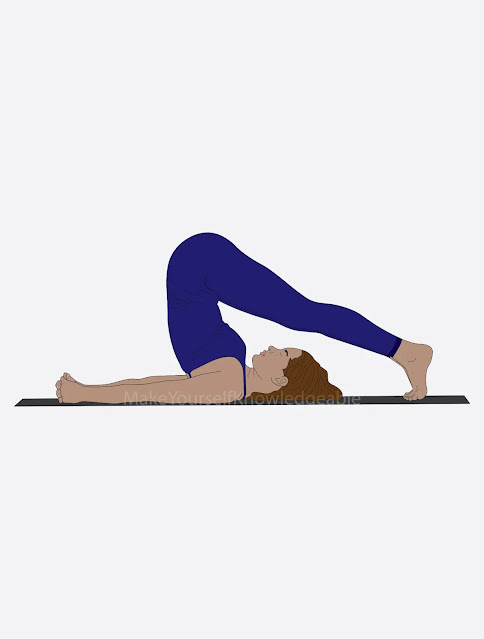Plough Pose is also known as Halasana. It stretches the vertebral column, shoulders, and back muscles. The pose improves muscles and joint mobility. Pregnant women and heart patients should avoid this pose because it puts pressure on your heart to pump blood faster and it's also dangerous for neck injury.
NOTE: Before you start this, consult your doctor or an exercise professional about this pose. Don't try to do it alone.
Tip To Do -
1 - Two blankets should be stacked with their edges aligned. Position the stack so that its edges meet the mat's center near the front of the mat.
2 - Lay back over the blankets while seated at the front of your mat so that they can support your torso. The back of your head should rest on the floor, and the tops of your shoulders should hang about an inch over the edge. Lay face up with a space between the back of your neck and the floor and a lengthy space in front of your neck.
3 - Straighten your legs toward the ceiling while bringing your knees to your chest. Lifting your hips off the ground while supporting yourself with both hands at your low or midback can help you roll up until your shoulders are supporting you. Put your hips higher than your shoulders.
4 - Until your toes touch the earth behind you, slowly lower your legs back over your head. Feet flexed, place your toes on the ground. Your arms should be on the ground with your palms facing down or clasped. To increase the lift along your spine, press down with your outside upper arms and shoulders.
2 - Lay back over the blankets while seated at the front of your mat so that they can support your torso. The back of your head should rest on the floor, and the tops of your shoulders should hang about an inch over the edge. Lay face up with a space between the back of your neck and the floor and a lengthy space in front of your neck.
3 - Straighten your legs toward the ceiling while bringing your knees to your chest. Lifting your hips off the ground while supporting yourself with both hands at your low or midback can help you roll up until your shoulders are supporting you. Put your hips higher than your shoulders.
4 - Until your toes touch the earth behind you, slowly lower your legs back over your head. Feet flexed, place your toes on the ground. Your arms should be on the ground with your palms facing down or clasped. To increase the lift along your spine, press down with your outside upper arms and shoulders.
5 - Hold this posture for at least five to ten breaths.
You Might Also Enjoy This
The Advantages of the Plough Pose
1 - The halasana opens up the spinal disc and aims to keep the spinal system youthful as it stretches the spinal muscles.
2 - Let go of the tension in your shoulders, arms, and spine.
3 - It is one of the best asanas to tackle obesity.
4 - By revitalizing the internal organs, it can cure indigestion and constipation and neck arthritis stiffness.
5 - Balances the thyroid gland.

